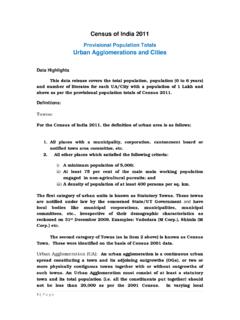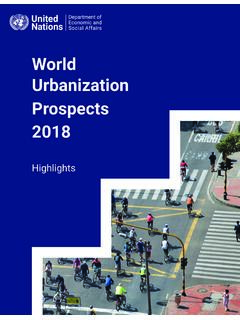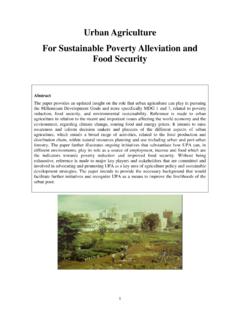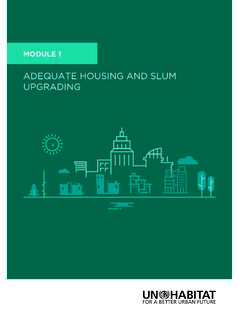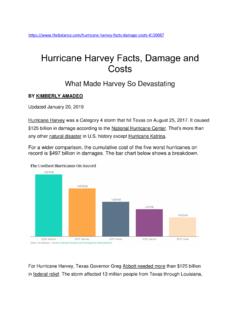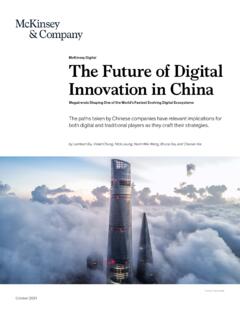Transcription of Car Sharing in Europe - Deloitte
1 Car Sharing in EuropeBusiness Models, National Variations and Upcoming DisruptionsDawn of a new eraFuture mobility is a pervasive theme a development which is still in its fledgling stage and has not yet reached its peak by a long way. Mega-trends, technology-led innovation, and regulatory conditions are changing the nature of mobility and bringing strategic and operational oppor-tunities as well as challenges for the various automotive players. The Sharing economy is approaching, while disruptive technologies inspire the emergence of new business models and set the course for a new era of (future) mobility. Car Sharing is a key aspect of this, and the market is committed to offering personal convenience and social s recent Global Automotive Consumer study highlighted the fact that Gen Y (those born between 1977 and 1994) desires connectivity and convenience and can choose from an ever-increasing range of transportation types, alongside vehicle ownership, for getting from A to B.
2 This 2bn strong consumer segment is the most influential since the Baby Boomers. The emerging mobility patterns of (young) adults are shaping an industry in which on-demand service providers such as Uber, DriveNow and car2go have experi-enced, and are still experiencing, significant growth and are unquestionably among the defining phenomena of our future mobility as well as the digital era. These providers are changing the way individuals move, by seamlessly connecting either drivers to passengers (taxi, car pooling) or passengers to cars (car Sharing ). The latter is enabled by technology and covers specific segments in the overall mobility market by offering a range of transport modes, from flexible one-way journeys to planned weekend round-trips. Car Sharing extends the benefits of automobility to Car Sharing in Europe | Business Models, National Variations and Upcoming Disruptions2individuals without them having to bear the cost and effort of car the Sharing economy provides favorable conditions for start-ups and attracts venture capital investors, estab-lished players in the automotive industry, both OEMs and car rental businesses, have shown strong interest in gaining a foothold, particularly in the car Sharing sector.
3 The automotive industry has gained momentum to become one of the forerunners by incorporating consumer trends with technology, while still giving users the unique feeling of driving a car. It is therefore no surprise that the automotive industry is closely interlinked with future mobility concepts such as car Sharing , car pooling, mobility services, and electromobility, as well as other high-quality innovations around digitalization and autonomous driving that are on the Sharing has continuously seen double-digit growth over the last few years, especially in bigger cities where more and more people are passing on the costs of car ownership. Positive knock-on effects include reduced traffic congestion and environmental benefits. While some of the most visible car Sharing providers began in the United States, the sector has become a global phenomenon, and Europe now represents over 50% of the global car Sharing market with users and 68,000 cars in 2016 (forecast).
4 A global compound annual growth rate of 32% for market revenue is expected by 2020. Well-known providers such as DriveNow and car2go are already estab-lished, not only in major cities in Germany, but all across Europe , the US, and Asia. While smaller cities and regional areas are being catered for by more regional providers, there is still considerable room for growth in this market; meanwhile, some experts predict a potential worldwide decline by more than half a million cars by 2021, due to the strong presence of car Sharing providers. This development is a global phenomenon that varies between individual countries. For instance, Germany is by far the biggest car Sharing market in Europe , where growth has accelerated since 2012 ( users), and is expected to keep momentum, reaching users by 2020. Despite this development, some experts do not predict a decline in car ownership, yet there are differences between urban and regional areas, and Germans in particular are emotionally connected to their own vehicles, and young drivers value powerful cars from well-known prominent position of car Sharing compared to other mobility services can be explained by the broad range of individual car Sharing business models that have emerged over time.
5 These cater for a diverse range of customer experience, at differentiated price points. Apart from price, mobility concepts can be classified by the flexibility offered to customers as well as the distance travelled, which takes into account the variation in usage areas from urban to regional (Fig. 1). They can be categorized as follows: free-floating and stationary B2C and B2B car Sharing can be seen as the two traditional car Sharing models and cater for specific needs. While free-floating models provide higher flexibility, and compete with taxis and new mobility providers such as Uber or mytaxi, stationary models are used for longer drives and tend to substitute rental cars or car ownership. Moreover, corporate car Sharing users are becoming an inevitable source of additional business for stationary car Sharing providers. B2B car Sharing is managed as a closed system in which employees can access vehicles on a Sharing basis, and is a strong alter-native for corporates to operating their own fleet.
6 These conventional free-floating and stationary approaches are well estab-lished in countries such as Germany and Italy, while for example in France another model is very prominent: peer-to-peer (P2P). This is a model where individuals FlexibilityDistance travelledLowHighLowHighCar poolingRental carTaxiBicyclePublictransportPeer-to-pee rcar sharingStationarycar sharingFree-floatingcar sharingFig. 1 Classification of car Sharing among existing mobility conceptsSource: Monitor Deloitte analysis and expert interviewsCar Sharing in Europe | Business Models, National Variations and Upcoming Disruptions3provide their own car for rental by private users via a platform. P2P provides a transportation mode for longer distances as compared to traditional car Sharing and corresponds more to an alternative to short-term car rental or car car Sharing business modelsCar Sharing is a very broad term and a differentiation with reference to the distinct business models is necessary.
7 They range from free-floating to stationary and P2P car Sharing . Some providers ( stadtmobil in Germany) offer both free-floating and stationary models, thereby offering the best of both worlds to their customers. Generally, these three business models (free-floating, stationary, combination) can cater to either B2C or B2B. In addition, another development can be observed in the car Sharing market, but will not be the focus of this Point of View: O2O platforms consolidate offerings by providing a link between online and offline, which enhances convenience and compa-rability for approach displays particular char-acteristics when it comes to product offering, pricing, pick-up and return, coop-eration, as well as ownership structure. While business model features may vary, car Sharing providers can guarantee positive prospects for success by meeting general success factors, high avail-ability and network coverage, transparent and flexible pricing, as well as fleet variety to cater for individual use cases.
8 In addition, providers as well as investors need to be aware of the unique success factors of each business model (Fig. 2).Free-floating car sharingThe fact that most free-floating providers have been in the market for less than five years highlights that this approach is still new; nevertheless, this market is booming. Free-floating allows customers to pick up and return the vehicle anywhere within a certain area and demonstrates this model s main advantage: flexibility. Free-floating cars are mainly used for short one-way (shopping or other leisure) trips in city areas, as an alternative to a taxi. German providers have a high turnover rate of 125 users/car, so that they can show profitable operations despite low utilization. Compared to stationary car Sharing , free-floating has higher prices that are often based on time only, and in particular become more expensive in case of traffic jams in city areas.
9 Given that operating areas are mainly in city centers, most free-floating providers offer small to medium-sized cars ( Smart, Mini), which also ensures relatively easy parking for users. The flexible parking policies require providers to cooperate with local authorities to avoid parking limitations. In 2014, car2go stopped operations in London after only 18 months, as they were not able to secure parking permits in all of London s individual free-floating providers are owned by OEMs (car2go by Daimler) and/or rental companies (DriveNow, a joint venture between BMW and Sixt), who view their investment in car Sharing as being purely strategic and not for financial reasons. They can use this channel to promote their cars and have direct access to customer order to be successful, free-floating providers need to consider the following success factors: Location: high population density to attract sufficient customers per car Pricing: based on time (mostly per minute), not distance Cooperation: local authorities have to grant parking spaces / permits Convenience: constant availability of (small) cars that fit needs in city areasStationary car sharingStationary car Sharing on the other hand can look back on a longer history (>20 years).
10 While free-floating emphasizes flexible one-way trips, stationary car Sharing has fixed stations and (usually) provides only round trips with the start and end points being the same. The use case is therefore more for longer trips and is likely to replace rental cars or (second) car ownership. What stationary providers may lack in flexibility, they make up for in fleet variety in terms of brands and models, catering for every need. Stationary car Sharing providers are located in small to medium-sized cities and rural regions. Utilization is higher due to longer drives and well-planned car utilization, while turnover is lower than for free-floating (45 users/car, Germany). FF = Free floating | S = Stationary | P2P = Peer-to-peerApplicableBusiness model featuresUsage area of vehicleVehicle typePricingParking co-operationsCity centerSmall/city carsBy timeParking permitsBroader city areaCompact carsBy distanceCommercialRegionalSUVs & MPVsFixed pricesPrivateFFFFFFFFSSSSP2PP2PP2PP2 PFig.










